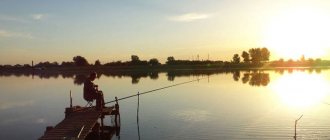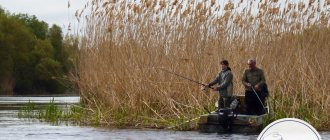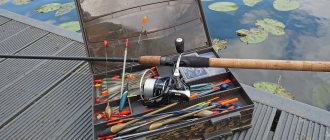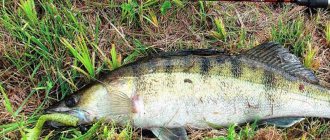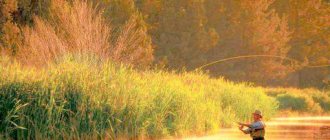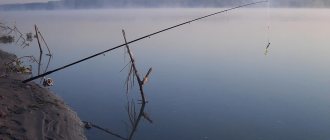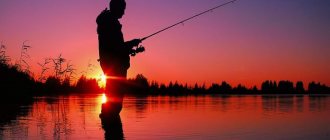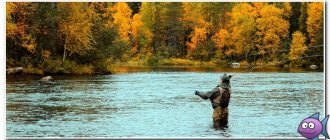Yuri 09/03/2020 689
Fishing for carp on the Volga lures not only local fishermen, but also amateurs from distant regions. This fish is famous for its tasty and juicy meat. Some specimens can reach up to 10 kilograms and have difficulty staying on a fishing rod. A trophy option is the dream of any fisherman.
A wild representative of the carp family, the carp is common in the southern regions. Due to the favorable climate of the Volga peals, carp are found in large numbers in reservoirs.
The carp has an elongated body, which allows it to quickly elude enemies. Large fish have no teeth, but only 2 whiskers on each side of the mouth. Mucus on the scales promotes heat exchange, which increases in the cold season in order to successfully overwinter. The sharp fin can injure even an experienced fisherman, so you should be careful.
Necessary gear
After catfish, carp is second on the list of the most attractive fish for those who come to fish on the Volga. The process of catching fish will give you great pleasure, so the gear must be strong and reliable.
Ideally, carp rods are used to catch carp, as well as a reel and stand with an electric bite alarm.
Budget carp reel Daiwa Black Widow with increased strength
Best option:
- Feeder rod Team Salmo ENERGY Feeder, length 3.9, test 120-250 g
- Daiwa Black Widow carp reel from our rating of the best Daiwa spinning reels.
- Salmo monofilament line, Feeder series. Thickness 0.3-0.4 depending on the expected trophy.
- Carp hooks Owner.
A few details about the choice
Feeder rod. Many fishermen, and some of them are experienced ones, make the same mistake - they choose the same feeder rod for different fishing conditions. When choosing gear, you should take into account the natural conditions in which you will be fishing and the fish you want to catch.
If we talk about fishing for carp on the Volga in the lower and middle reaches, at medium and long distances, then the feeder rod should be of the medium, heavy or super-heavy power class and at least 3.9 meters long. Very rarely, in places with weak currents, at short distances a short rod (2.7 - 3.3 m) of a light power class will be more effective.
Coil. When choosing a reel, pay attention first of all to the spool diameter and gear ratio.
These indicators should be quite high. They will provide you with quick unwinding of the gear. In general, for fishing on such a fast river as the Volga, experienced fishermen use a free-running reel. The functions of the reel will allow you to rewind a little fishing line, which will go under the water, forming an arc, which will prevent the load from being torn off from the bottom by the force of the current. Fishing line. Here the opinion of fishermen is divided:
- Some people prefer wicker. It does not stretch, bites are very clearly visible. Prevents the fish from going into snags. But the disadvantage is that it rubs against stones and snags. Although we recommend fishing lines with a high-class hardening coating, for example Salmo Elite Braid 0.2-0.24 .
- Another part of the fishermen prefers high-quality monofilament fishing line - it stretches a little, which makes it possible to additionally dampen the jerks of strong carp. Less rubbing on stones. The disadvantage is that it is a little thicker and stiffer, which affects the casting distance. Also, it still stretches, which requires the fisherman to fish with constant retreat back along the shore in order to prevent the carp from going into the snags. We recommend Salmo Specialist Feeder 0.3-0.4 mm
.
You need to choose a fishing line based on the fishing conditions, your gear and fishing style.
Replaceable tip (quivertip). Here you also need to take into account the natural features of fishing. For fishing in strong currents, it is necessary to install rigid tips. However, there shouldn’t be any problems with this; any feeder or carp rod, even a budget class one, has interchangeable tips.
A shock leader is a piece of monofilament, 6-10 m long, tied to the main fishing line. It is used when they want to avoid shooting equipment when using heavy loads and feeders. The correct knot for a shock leader is described here.
Leadcore is another important component of carp equipment, especially important when fishing on stones or snags. Leadcore will prevent the fishing line from rubbing on the stones and will submerge the equipment so as not to arouse suspicion in the carp of the presence of foreign bodies in the form of a stretched fishing line.
Tourist base "Zavolzhye" - relaxation and fishing for carp
Residents of the capitals and central regions of Russia who want to catch an impressive representative of the carp family will not be left without a trophy if they decide to go to the Zavolzhye fishing base, which is located on the Lower Volga in Astrakhan.
Comfortable living conditions at very affordable prices, fish soup made from fish caught with your own hands, fresh air, beautiful landscapes of the Volga and Akhtuba - only here you can understand how little a person needs to be happy.
Groundbait and feeder feeding techniques
Feeder bait is either made independently or purchased in stores.
We have already written a detailed guide about mixtures and techniques for feeding carp. We recommend combining homemade bait with store-bought bait for two reasons:
- Store-bought bait contains very active flavoring additives, which will attract carp downstream from distant sites. Also, many professional baits from the Trapper and Dunaev series contain bite activators, which help improve the digestion of wild carp.
- Homemade bait, in turn, is nutritious and rich in natural carbohydrates and proteins. Having tried this bait, the carp will not refuse the table and will continue to feed for a long time.
Be sure to add an animal component to the bait. In cold water it is 1/3 of the total bait, in warm water in the summer it is 1/10 or 1/15 of the total bait. If you try for a worm, then feed it with chopped worms. The vegetable component of the bait should also be in the bait - corn, green peas, pearl barley, boilies.
Add to the bait only those baits that you intend to fish with.
Optional Popular Supplements
In the southern regions of the Volga, carp are fed with the inclusion of shell meat in the bait. To do this, take out the pulp, chop it finely, and add shell shells.
You can make bait based on semolina. Take sunflower cake, mix with breadcrumbs, mixed feed, semolina and lightly steamed oatmeal.
When fishing in medium and fast currents, wheat bran is added to the bait (preferably unevenly ground). By dissolving in water, particles of such bait will create turbidity, which is attractive to carp. Wheat bran is steamed for a long time over low heat.
In bays and places with weak currents, bait is made in such a way that when dissolved in water, it forms a suspension that will spread far and wide an attractive smell for carp.
Feeder feeding technique
Open feeder
- Here is what the sequence of your actions should be:
- Leave only the open-type feeder on the rig; do not attach the leash with the hook yet.
- Fill the feeder with bait, compacting it a little on the sides, but not too much, so that when you reach the bottom and jerk with the rod, the bait can wash out to the bottom.
- Make a cast with 80-90% strength and based on a landmark on the opposite bank (a tree, a house, but not a cloud or a car, which can move over time).
- As soon as the feeder falls into the water, close the line handle and place the feeder rod on the stand. After this, the line will be stretched for some time, and the feeder will continue to fall to the bottom.
- Clip the line into the special clip on your spool. It usually has the shape of a regular triangle with soft edges. After this, when casting with 100% of your strength, you will always hit the same place along the length of the line. All that remains is to aim at the landmark on the opposite bank.
- After the feeder falls to the bottom, the line will sag and the tip will weaken. We wait 5-10 seconds and make a strong jerk so that the food is washed out of the feeder. Then we take the feeder out of the water and repeat the entire procedure 10-15 times.
Tips for feeding in strong currents:
- Be sure to use feeders from 120 g. This way you will ensure that the bottom reaches the bottom as quickly as possible in the place where you threw it.
- When feeding and when catching, use feeders of the same weight and aerodynamic shape. Otherwise, you will feed in one place and try to catch the carp in another.
- Cast a little higher upstream so that the feeder hits the bottom exactly perpendicular to the bank from you.

